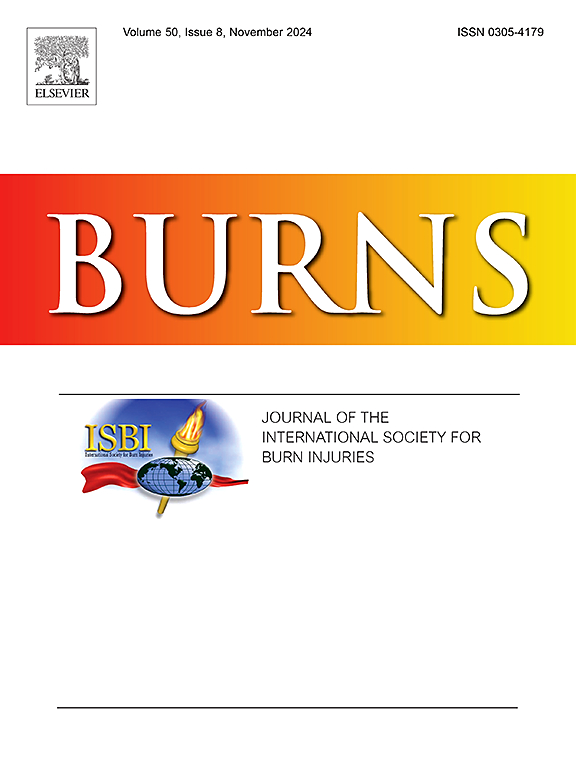Grading criteria on radionecrosis of skin (GCRNS) in adult patients: Insights from Delphi study and validation process
IF 2.9
3区 医学
Q2 CRITICAL CARE MEDICINE
引用次数: 0
Abstract
Background
Radionecrosis of skin (RNS) is the severe consequence of radiodermatitis (RD), which is a common complication experienced in up to 95 % of cancer patients after radiation therapy (RT). Recent publications revealed an absence of grading criteria for RNS and only crude forms for RD. However, treatments for RNS of different severity vary widely in terms of treatment difficulty and prognosis. This Delphi study aims to provide wound repair surgeons and oncologists a comprehensive guide for accurate RNS diagnosis, facilitating more effective surgical or operative interventions.
Methods
A three-round Delphi method was conducted between May and September 2022, involving 24 experts who specialize in the care or research of RNS. The process identified and weighted primary and secondary items to create a scale that reflects the severity of RNS. A receiver operating characteristic (ROC) curve was generated using the expert’s ratings (n = 15) as the benchmark to establish the grading criteria on RNS (GCRNS) with patient data (n = 64). To assess test-retest reliability, 32 physicians re-evaluate 64 patients’ files 2 weeks after their initial evaluation. The correlation between expert ratings and physician's re-evaluated grading was calculated to confirm concurrent validity.
Results
The final GCRNS consisted of 18 secondary items categorized under 6 primary items, including ulcer duration, peripheral skin, ulcer area, underlying disease, ulcer depth, and severe complications. Severity classification thresholds were proposed by ROC curve, defining severity levels as mild, moderate, and severe. Six primary items were positively correlated the severity of RNS with affirming its concurrent validity (r = 0.751, p < 0.001). Good internal consistency (α=0.831) and test-retest reliability (r = 0.969, p < 0.001) were demonstrated.
Conclusions
GCRNS is an expert-driven and comprehensive approach to RNS assessment for further wound repair. By improving diagnostic accuracy, particularly among junior surgeons, GCRNS with strong concurrent validity and reliability, enhances clinical decision-making and supports more effective treatment planning.
成人患者放射性皮肤坏死(GCRNS)的分级标准:来自德尔菲研究和验证过程的见解。
背景:放射性皮肤坏死(RNS)是放射性皮炎(RD)的严重后果,是高达95% %的放射治疗(RT)后癌症患者的常见并发症。最近的出版物显示,缺乏RNS的分级标准,只有粗略的RNS形式。然而,不同严重程度的RNS的治疗在治疗难度和预后方面差异很大。本德尔菲研究旨在为伤口修复外科医生和肿瘤学家提供准确的RNS诊断的综合指南,促进更有效的外科或手术干预。方法:采用三轮德尔菲法,于2022年5月至9月对24名专门从事RNS护理或研究的专家进行调查。该过程对主要和次要项目进行识别和加权,以创建反映RNS严重程度的量表。以专家评分(n = 15)为基准,生成受试者工作特征(ROC)曲线,结合患者数据(n = 64)建立RNS (GCRNS)分级标准。为了评估重测信度,32名医生在初次评估后2周重新评估64名患者的档案。计算专家评分和医生重新评估评分之间的相关性,以确认并发效度。结果:最终GCRNS包括溃疡持续时间、周围皮肤、溃疡面积、基础疾病、溃疡深度和严重并发症6个主要项目下的18个次要项目。根据ROC曲线提出严重程度分类阈值,将严重程度分为轻度、中度和重度。六个主要项目的RNS严重程度与其并发效度呈正相关(r = 0.751,p )结论:GCRNS是一种专家驱动的、全面的RNS评估方法,可用于进一步的伤口修复。通过提高诊断准确性,特别是在初级外科医生中,GCRNS具有较强的并发效度和信度,可以增强临床决策并支持更有效的治疗计划。
本文章由计算机程序翻译,如有差异,请以英文原文为准。
求助全文
约1分钟内获得全文
求助全文
来源期刊

Burns
医学-皮肤病学
CiteScore
4.50
自引率
18.50%
发文量
304
审稿时长
72 days
期刊介绍:
Burns aims to foster the exchange of information among all engaged in preventing and treating the effects of burns. The journal focuses on clinical, scientific and social aspects of these injuries and covers the prevention of the injury, the epidemiology of such injuries and all aspects of treatment including development of new techniques and technologies and verification of existing ones. Regular features include clinical and scientific papers, state of the art reviews and descriptions of burn-care in practice.
Topics covered by Burns include: the effects of smoke on man and animals, their tissues and cells; the responses to and treatment of patients and animals with chemical injuries to the skin; the biological and clinical effects of cold injuries; surgical techniques which are, or may be relevant to the treatment of burned patients during the acute or reconstructive phase following injury; well controlled laboratory studies of the effectiveness of anti-microbial agents on infection and new materials on scarring and healing; inflammatory responses to injury, effectiveness of related agents and other compounds used to modify the physiological and cellular responses to the injury; experimental studies of burns and the outcome of burn wound healing; regenerative medicine concerning the skin.
 求助内容:
求助内容: 应助结果提醒方式:
应助结果提醒方式:


